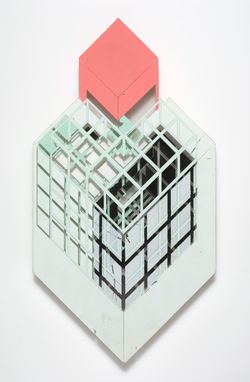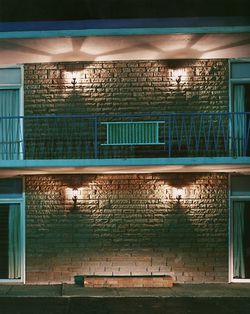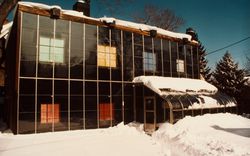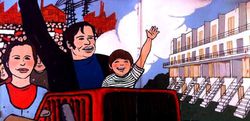Through the work of internationally renowned architects, this exhibition reveals the presence of utopian modernist ideas thought to have been discarded with the advent of the postmodern era. According to the exhibition’s lead curator Reinhold Martin, much of the architectural production of the last half-century has been haunted by the ghosts of modernist utopias: “The(...)
Octagonal gallery
28 February 2008 to 25 May 2008
Utopia's Ghost: Postmodernism Reconsidered
Actions:
Description:
Through the work of internationally renowned architects, this exhibition reveals the presence of utopian modernist ideas thought to have been discarded with the advent of the postmodern era. According to the exhibition’s lead curator Reinhold Martin, much of the architectural production of the last half-century has been haunted by the ghosts of modernist utopias: “The(...)
Octagonal gallery
In 1973, following the strikes that beset the British construction industry during the early 1970s, Alistair McAlpine commissioned a design program for his construction company, Sir Robert McAlpine Sons, that aimed to increase production efficiency and improve labour relations. Cedric Price’s proposal took the format of a two-volume report and a Portable Enclosures(...)
9 February 2017 to 14 May 2017
What About Happiness on the Building Site?
Actions:
Description:
In 1973, following the strikes that beset the British construction industry during the early 1970s, Alistair McAlpine commissioned a design program for his construction company, Sir Robert McAlpine Sons, that aimed to increase production efficiency and improve labour relations. Cedric Price’s proposal took the format of a two-volume report and a Portable Enclosures(...)
Series
AP115.S1
Description:
Cette série porte sur le travail de documentation photographique de Robert Duchesnay d'un des exemples construit du Dymaxion Dwelling Machine, à Wichita, Kansas, aux États-Unis. Le Dymaxion Dwelling Machine, concept conçu par Buckminster Fuller et considéré comme le précurseur du dôme géodésique, visait a créer un mode d'habitation donnant un maximun d'espace pour un minimum de coût et de matériaux. L'exemple du Wichita House est conçu par Fuller en 1945-1946. "L'apparence de cette machine à habiter ressemble quelque peu à une soucoupe volante. Avec sa peau externe en aluminium et ses fenêtres en plexiglass, elle offre un surface élégante et profilée, tout en renferman un espace au sol de 1100 pieds carrées." [1] Le Dymaxion Dwelling Machine est abandonné en 1970, pour être finalement acquise en 1990 par le Henry Ford Museum à Detroit, au Michigan. La structure est démantelé la même année avec l'aide d'un ancien collaborateur de Buckminster Fuller, Jay Baldwin. Le Dymaxion Dwelling Machine est toujours visible au Ford Museum. La série contient des photographies de la Wichita House avant et durant le démantèlement, brochures et feuillets du Wichita Art Museum présentant l'exposition de Robert Duchesnay sur le bâtiment, correspondance reçue par Duchesnay sur son projet de documentation des dômes géodésiques de Buckminster Fuller, et coupures de presse sur le Dymaxion Dwelling Machine et le démantèlement de la Wichita House. [1] Robert Duchesnay, "Dymaxion Dwelling Machine", 2022, https://robertduchesnay.com/fr/dymaxion-fr/ (page consultée 27 février 2023).
1990-1992
Dymaxion Dwelling Machine, Wichita, Kansas
Actions:
AP115.S1
Description:
Cette série porte sur le travail de documentation photographique de Robert Duchesnay d'un des exemples construit du Dymaxion Dwelling Machine, à Wichita, Kansas, aux États-Unis. Le Dymaxion Dwelling Machine, concept conçu par Buckminster Fuller et considéré comme le précurseur du dôme géodésique, visait a créer un mode d'habitation donnant un maximun d'espace pour un minimum de coût et de matériaux. L'exemple du Wichita House est conçu par Fuller en 1945-1946. "L'apparence de cette machine à habiter ressemble quelque peu à une soucoupe volante. Avec sa peau externe en aluminium et ses fenêtres en plexiglass, elle offre un surface élégante et profilée, tout en renferman un espace au sol de 1100 pieds carrées." [1] Le Dymaxion Dwelling Machine est abandonné en 1970, pour être finalement acquise en 1990 par le Henry Ford Museum à Detroit, au Michigan. La structure est démantelé la même année avec l'aide d'un ancien collaborateur de Buckminster Fuller, Jay Baldwin. Le Dymaxion Dwelling Machine est toujours visible au Ford Museum. La série contient des photographies de la Wichita House avant et durant le démantèlement, brochures et feuillets du Wichita Art Museum présentant l'exposition de Robert Duchesnay sur le bâtiment, correspondance reçue par Duchesnay sur son projet de documentation des dômes géodésiques de Buckminster Fuller, et coupures de presse sur le Dymaxion Dwelling Machine et le démantèlement de la Wichita House. [1] Robert Duchesnay, "Dymaxion Dwelling Machine", 2022, https://robertduchesnay.com/fr/dymaxion-fr/ (page consultée 27 février 2023).
Série
1990-1992
The greystone buildings standing in Montreal today are essential tools for understanding the city. A deep study of their material history from the late 17th century to the early 20th demonstrates how geology, topography, politics, ethnicity, culture, as well as changes in economy and technology, have shaped the city through the centuries. Conceived as a photographic(...)
Octagonal gallery Keyword(s):
Greystone, Phyllis Lambert, Montréal, photography, Richard Pare
13 October 2017 to 4 March 2018
Greystone: Tools for Understanding the City
Actions:
Description:
The greystone buildings standing in Montreal today are essential tools for understanding the city. A deep study of their material history from the late 17th century to the early 20th demonstrates how geology, topography, politics, ethnicity, culture, as well as changes in economy and technology, have shaped the city through the centuries. Conceived as a photographic(...)
Octagonal gallery Keyword(s):
Greystone, Phyllis Lambert, Montréal, photography, Richard Pare
Architectural historian Barbara Penner traces the evolution of Niagara Falls – from its 19th-century honeymoon tourism to its state of post-industrial kitsch to its recent rebirth as a honeymoon destination. The photographer Alec Soth, whose work is the starting point for this lecture, compellingly portrays a ruined post-industrial landscape of love in his series Niagara(...)
Paul Desmarais Theatre
23 April 2009
Learning from... Niagara Falls
Actions:
Description:
Architectural historian Barbara Penner traces the evolution of Niagara Falls – from its 19th-century honeymoon tourism to its state of post-industrial kitsch to its recent rebirth as a honeymoon destination. The photographer Alec Soth, whose work is the starting point for this lecture, compellingly portrays a ruined post-industrial landscape of love in his series Niagara(...)
Paul Desmarais Theatre
articles
The planet is the client
articles
The planet is the client
3 August 2023, 6pm to 7:30pm
Visiting Scholar Irene Sunwoo presents her research: During the 1970s and 1980s, the Architectural Association (AA) in London tested a “marketplace” model of architectural education that supported an array of theoretical investigations. Exploring issues including politics, phenomenology, semiotics, sustainability, literature, and third-world housing, the school became a(...)
Shaughnessy House
27 July 2017, 6pm
Visiting Scholar Seminar: Irene Sunwoo
Actions:
Description:
Visiting Scholar Irene Sunwoo presents her research: During the 1970s and 1980s, the Architectural Association (AA) in London tested a “marketplace” model of architectural education that supported an array of theoretical investigations. Exploring issues including politics, phenomenology, semiotics, sustainability, literature, and third-world housing, the school became a(...)
Shaughnessy House
Evoking a provocation famously framed by Le Corbusier, “Architecture ou Révolution,” this conversation will situate the SAAL process in Portugal within international debates during the 1960s and 1970s on social housing and the architect’s social responsibility. Nuno Portas, Secretary of State for Housing and Urbanism of the government established after the 1974 Portuguese(...)
Paul-Desmarais Theatre
14 May 2015 , 6pm
Architecture or Revolution? A Conversation with Nuno Portas and Nuno Grande
Actions:
Description:
Evoking a provocation famously framed by Le Corbusier, “Architecture ou Révolution,” this conversation will situate the SAAL process in Portugal within international debates during the 1960s and 1970s on social housing and the architect’s social responsibility. Nuno Portas, Secretary of State for Housing and Urbanism of the government established after the 1974 Portuguese(...)
Paul-Desmarais Theatre








